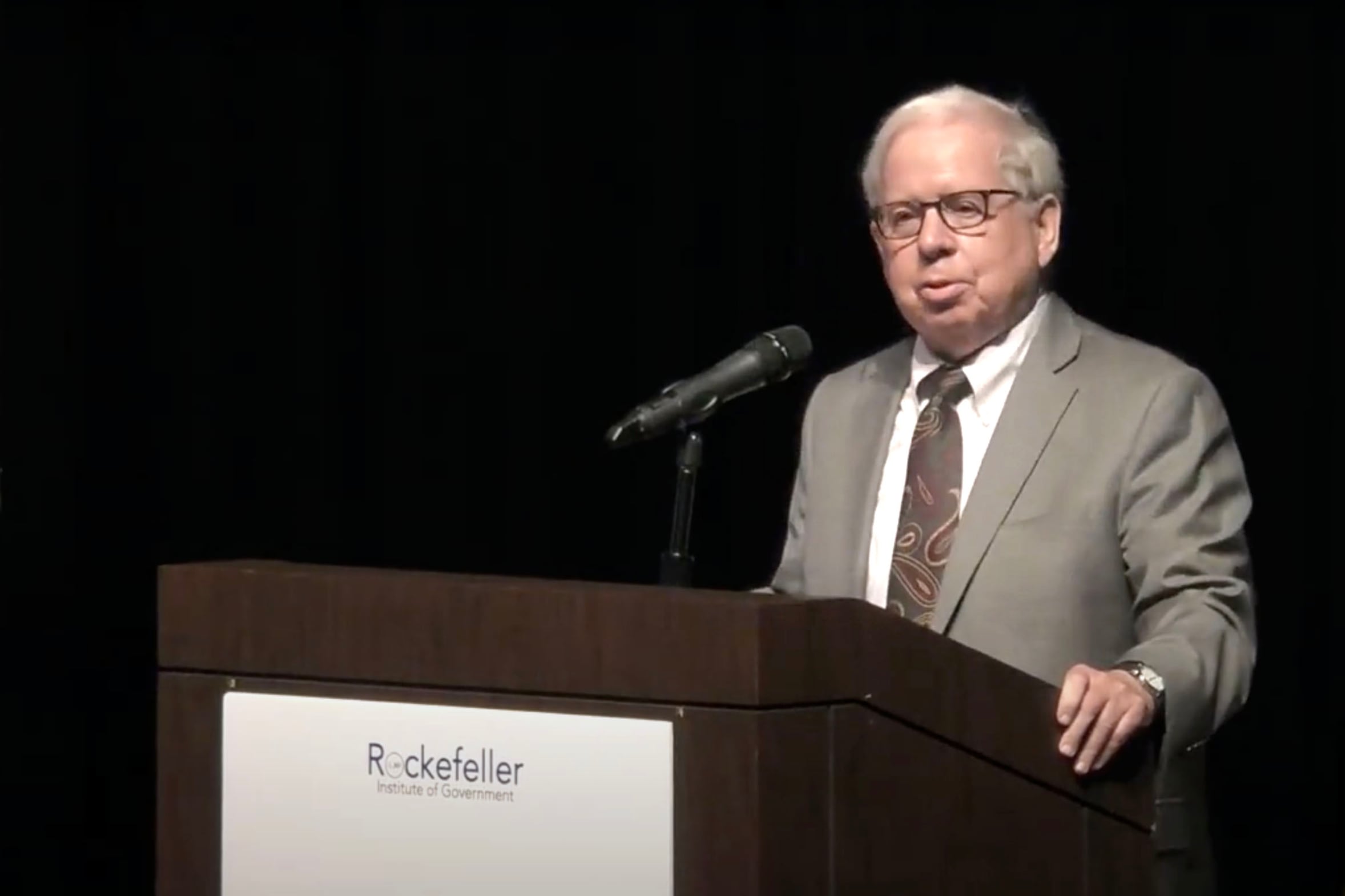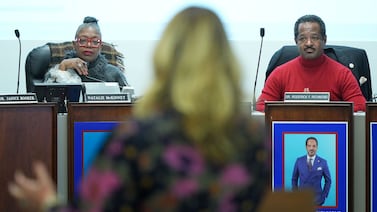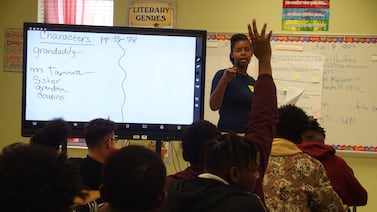Sign up for Chalkbeat New York’s free daily newsletter to keep up with NYC’s public schools.
More than 30 years ago, the Campaign for Fiscal Equity filed a landmark case against the state of New York, alleging that its school funding system violated the constitutional right of New York City students to a “sound basic education.” After a drawn out legal fight, the state’s highest court agreed.
It paved the way for the state’s Foundation Aid formula, which determines how much money is sent to school districts based on student need — for example, providing additional funding to districts that serve higher populations of students in poverty, among other factors. That formula, implemented in 2007, didn’t receive full funding for more than a decade. In the coming year, New York officials may revise the formula amid widespread concerns that it’s outdated.
Now, a lawyer who led the Campaign for Fiscal Equity, or CFE, during its legal fight claims the state’s approach to updating the formula is unconstitutional.
As part of a state budget agreement earlier this year, the Rockefeller Institute is conducting a study on how to revise the formula, which sends roughly $24.9 billion to districts — including more than $9.5 billion to New York City schools. The institute began holding a series of public hearings this month, taking place in Manhattan and other districts across the state, to solicit testimony on the current formula.
Michael Rebell, executive director of the Center for Educational Equity at Columbia University’s Teachers College and the lawyer who led CFE, argues it isn’t enough just to tweak the nearly two-decade-old formula. Instead, he believes a true accounting of student needs requires going back to the drawing board — and that’s exactly what he intends to do.
The Center for Educational Equity will undergo its own effort to create a fair and equitable school funding formula, Rebell said.
Chalkbeat asked Rebell about this effort, why he believes the state’s approach falls short of its constitutional mandate, and whether he’s gearing up for another legal fight.
This interview has been edited for length and clarity.
You’ve referred to the Foundation Aid formula as outdated. Can you talk about some of the ways it’s failing to meet student needs?
To start off, the statistic that they use for counting the number of poverty-students is based on the 2000 census, or at least part of it is. Just out of the box, that is crazy. We’re looking at poverty figures from 24 years ago. Needless to say, in New York City, and in the rural areas all over the state, there have been huge changes.
It’s the same with this regional cost factor. That figure comes from 2006. It’s kind of nuts that we’ve got an 18-year old figure determining what’s a fair cost of living difference between the different parts of the state.
A lot of major changes have happened in the last 18 years. Some of the most obvious are: We didn’t know anything in those days about migrant students, and that’s become a big burden on New York City, on some of the Long Island districts, elsewhere in the state.
It’s the same with students in temporary housing. That was a minor issue in those days. There were a relatively small number of those kids, so that was also not put into the formula. But right now, we’ve got 10% or 11% of the students in New York City public schools in temporary housing, and as many people testified, there are a lot of extra costs that go along with that.
I’m from New York City. We’re certainly going to be sensitive to New York City’s interests, but we’re also concerned about kids throughout the state in rural areas. There’s a problem about “hold harmless.” And the reason that the legislature has been holding a lot of those districts harmless for the last five or six years is they’ve lost a lot of population. And there are some real questions about how you can have a viable school system if you’re substantially cut.
I’m not claiming to have an easy answer to that, but we are going to look into that.
Besides that, we have new needs like pandemic learning loss, and much greater concerns and issues about mental health throughout the state. So that’s why we’ve been saying for the last couple of years, “What you really need to do is start from scratch and say, let’s look at current needs — and once we examine what those current needs are, let’s come up with a fair formula.”
Our position is: That is exactly what the Constitution requires.
During your testimony, you said the state’s current approach to updating the Foundation Aid formula is “unconstitutional.” What is the constitutional mandate here, and why do you believe the state’s approach falls short of it?
The CFE case we started in 1993. Ten years later, we got this amazing decision from the highest court in the state that upheld our position 100% and more.
The system that was in effect before this court order was basically political wheeling and dealing. The powers that be — the speaker, the majority leader, and the governor — would go in a backroom somewhere, and they’d decide how much money we were going to spend on education, health, welfare, whatever. How much we were willing to raise taxes. Whatever it was to determine how much money was needed. But the basic consideration was a political calculation: How much do we want to spend on education? And then: How are we going to divvy up whatever that amount is?
That was always a political power play. Whoever was in control of the legislature was in control of how that pie was divvied up.
We found some correspondence that went from the Office of the Speaker to the state Education Department. This was a message saying, “All right, the decision has been made. Here are the percentages for this year. New York City gets 38.86% of the following amount, which is what the leaders agreed to. Run the figures and do it any way you want, but just make sure the bottom line is that New York City gets 38.86%.”
In other words, they’d have 50 different formulas, and depending who they felt they had to appeal to politically, they put more money in that basket.
We brought that to the court’s attention and they were just flabbergasted.
The court had already said the Constitution requires the state to provide all kids the opportunity for sound basic education. So in the decision, they said very clearly about five times, “The formula has to be based on need.”
The state must determine what is the amount of money you need for sound basic education based on relative need. Now that is the most critical thing, and that’s really what we’re relying on here. Essentially, the court was saying, “You don’t go in a backroom and throw around figures depending on political power.” You come up with some system that clearly and fairly looks at what the needs are, and you say, “Here’s the amount of money we need.” You don’t say, “Here’s the amount we’re willing to spend.”
That’s why we say it’s unconstitutional to do what the governor has been doing, because she’s not attempting to develop a new formula to determine what is the amount of funding we need based on need in 2024.
What does a constitutionally compliant school funding project look like? What work will the Center for Educational Equity be engaging in?
When we saw that the state was not going to do anything to move this forward, we got some support from a couple of foundations, and we’re entering into contract with the American Institutes for Research, which is one of these national firms that has a lot of experience and a lot of expertise in developing methodologies.
So we’re going to work with them to develop a new formula. We’re going to do stage one of it, but it’s really the state’s responsibility.
Offhand, there are six different ways of calculating poverty. Our people will come up with one of them, and we’ll have reasons for that, but in good faith, somebody else may say the other way of doing it is better. So it’s not an exact science. You can’t find the golden number, and everybody’s going to fall in line — which is why, if the state sets up a fair way of doing it, we’re better off having the state do it. If we come up with what we think is a fair, objective formula, well, we then have to advocate for it. If we have to, we’ll do that. But what I’d rather do is start the process.
During the current budget cycle, AIR is going to do what’s called a cost function analysis, a statistical pulling together of all of the relevant data that you can find, and doing a lot of data runs to figure out various ways of doing things.
So again, if we take poverty, there are six different ways that have been identified to calculate poverty. They’ll put in all the data for New York state and every school district in New York state, and they’ll give us what the outcome would be of the six different ways of doing it. So all of this statistical work that you need as a basis for making decisions will be done, but it’s all based on statistics.
There are things that you don’t have any statistics about. We’ve been very big on the importance of civic education recently, just to give an example. So the extra costs for getting students engaged in community engagement programs, we think is one of the best ways to get students civically involved. That costs money. It’s extra teacher time. It’s extra mentoring. Somehow, that should come into the calculation, if we want to make civic education a priority. I’m just picking up that one example, but you can imagine all kinds of qualitative things that need to be taken into account. That’s why you do need human judgment coming into it.
We’re going to do this cost analysis part of it, and we’re going to do that by next spring, when they’re doing the budget. But it’s got to have this qualitative thing. That’s part two. And we hope that by publicizing this, and keeping the pressure on them and saying, “We’ve already done some of the work for you, so it’ll be less expensive for you to do it next year. You guys can hire AIR or some other firm if you prefer, but pick up what they did. You’ve got all the statistical data now.
Get the job done in the second year.”
If the state chooses to continue with its approach, would you consider further legal challenges?
When the state was dragging its heels and not paying out the CFE money, we did bring another case. We filed it in 2014. These cases take a long time. It’s an enormous amount of data you have to pull together to prove to a court that they’re not meeting their responsibilities. We were ready to go to trial when the pandemic was starting, and that’s when Gov. Hochul came in. We had had this problem with Andrew Cuomo for years, and he wouldn’t budge. So we said, “We’re bringing you to court.” And we did. And as I said, the case was ready to go, and Hochul said, “Wait a minute… I’m going to settle this case. We’ve got a moral obligation. We should pay out the money.”
I don’t lightly threaten going to litigation, and to tell you the truth, I’ve done this twice — I’m not eager to do it again. Courts are not going to decide this overnight, so we’d rather work it out this way. We don’t want to wait years.
So I’d rather not, but I’m not telling you we wouldn’t.
Julian Shen-Berro is a reporter covering New York City. Contact him at jshen-berro@chalkbeat.org.





